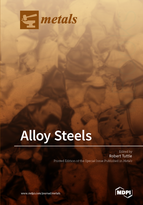Alloy Steels
A special issue of Metals (ISSN 2075-4701).
Deadline for manuscript submissions: closed (30 September 2017) | Viewed by 144847
Special Issue Editor
Interests: ferrous molten metal processing; nondestructive testing; failure analysis
Special Issues, Collections and Topics in MDPI journals
Special Issue Information
Dear Colleagues,
Steels have been long known for their strength and toughness. This combination has made them perhaps the most important industrial alloys used by man. Representing a significant portion of steel production and use, alloy steels have been produced since 1865. Classically, the focus of alloy steels has been on producing a harder and stronger tempered martensite structure or improving properties, such as corrosion resistance. However, for the last thirty years, the steel industry has concentrated considerable efforts on low alloy steels to provide weldability and strength. More recently, high alloy steels have become increasingly important as they provide unique deformation mechanisms, such as TRIP or TWIP, which furnish the metallurgist with a new combination of strength and ductility. These newer alloys are being examined for use in automotive applications so that safety and fuel economy can be improved to meet tomorrow’s demanding requirements. There has also been renewed interest in advancing niche steels such as the Hadfield or Manganese steels due to their importance in mining or other key markets. Improving niche steels are necessary to reduce environmental impact and deliver a modern standard of living to everyone on the planet.
In this Special Issue, we seek to provide a wide set of articles on various aspects of alloy steels. The idea is to demonstrate the broad range of properties and applications of these steels. It is hoped that this open access issue will provide a place for anyone to familiarize themselves with the current state of the art for these alloys. Articles on the metallurgy, production methods, defect elimination, and performance in final products of alloy steels are desired.
Prof. Dr. Robert Tuttle
Guest Editor
Manuscript Submission Information
Manuscripts should be submitted online at www.mdpi.com by registering and logging in to this website. Once you are registered, click here to go to the submission form. Manuscripts can be submitted until the deadline. All submissions that pass pre-check are peer-reviewed. Accepted papers will be published continuously in the journal (as soon as accepted) and will be listed together on the special issue website. Research articles, review articles as well as short communications are invited. For planned papers, a title and short abstract (about 100 words) can be sent to the Editorial Office for announcement on this website.
Submitted manuscripts should not have been published previously, nor be under consideration for publication elsewhere (except conference proceedings papers). All manuscripts are thoroughly refereed through a single-blind peer-review process. A guide for authors and other relevant information for submission of manuscripts is available on the Instructions for Authors page. Metals is an international peer-reviewed open access monthly journal published by MDPI.
Please visit the Instructions for Authors page before submitting a manuscript. The Article Processing Charge (APC) for publication in this open access journal is 2600 CHF (Swiss Francs). Submitted papers should be well formatted and use good English. Authors may use MDPI's English editing service prior to publication or during author revisions.
Keywords
- Alloy steels
- TWIP
- TRIP
- Casting
- Quench and partition
- Nickle-chromium steels
- Tungsten steels
- Defect elimination
- Forging






